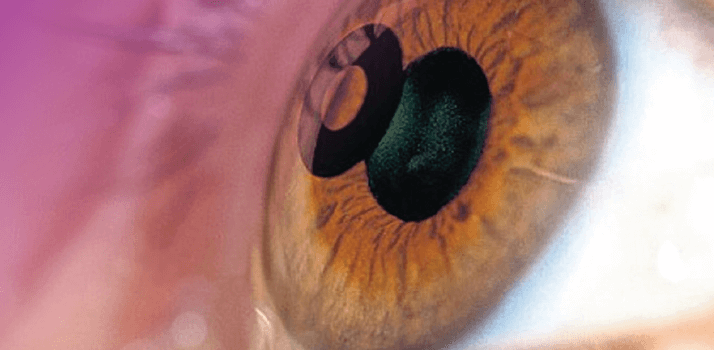
- The number of presbyopes is increasing dramatically
- New approaches improve vision and quality of life
- To build your practice, good customer interaction, education and listening skills are crucial
- Everyone should have a presbyope on their staff
When you first have to put on reading glasses to decipher the reading card that your patient is looking at, you will feel slightly perturbed. But when you have to slide the card under the slit lamp to see if they are reading it correctly, you’ll be truly dismayed. We both know this from personal experience. To us it feels that presbyopia is ubiquitous; indeed, the statistics tell us we’re not far off. Happily, there are exciting new options for treating us and our presbyopic patients, and we are now orienting our practices towards them.
Historically, our practice has been focused on refractive surgery. While the LASIK market remains significant, the numbers have leveled off. The global presbyopic population, on the other hand, is large and continuing to grow. It is projected that by the year 2020 there will be over 336 million in the United States and over 410 million in Western Europe. This population is physically active and engaged in activities that require a full range of vision. For instance, 66 percent send text messages, 90 percent use a computer and 72 percent plan on continuing to work in some capacity after retirement. These days, presbyopes generally feel younger than their chronological age and are frustrated with reading glasses which, they find, intrude on their lifestyles. Plus, wearing reading glasses is a definite – and most unwelcome – sign of aging.
MYOPES vs PRESBYOPES
The nature of the condition can be difficult to get across. Explaining the concept to hyperopic presbyopes is especially challenging: in spite of long conversations, some patients fail to truly understand that their eyes can no longer make the accommodation from distance to near focus. We try to explain to these presbyopes that if we correct their distance vision, everything up close will be blurry, and they likely won’t be able to read or see anything within arm’s reach without help. Patients often respond that they can currently read without their glasses, and they don’t want that changed, failing to understand what they have just been told. They ask us to just correct their distance vision and leave their reading vision as is. Even patients who seem to understand come back after surgery dismayed that they can’t do crossword puzzles or shave their armpits.
A new intervention
Historically, surgical options for presbyopes have predominantly involved some form of refractive surgery that resulted in monovision. For some patients, this can be a great option. The average success rate for elective monovision surgery is reported to be 73 percent (1), which more or less coincides with the experience in our practice: even though we require a contact lens trial prior to surgery to ensure they can adapt, of the 15 percent of patients on which monovision was performed, about a third ended up having the procedure reversed. The reality is that when you give a patient really crisp distance vision, there is a wow factor but when they are able to see and function at both near and far – but neither is spectacular – the response ranges from ambivalence to annoyance.
Another option is the small-aperture corneal inlay which is available in many countries worldwide and under review by the Food and Drug Administration (FDA) in the USA. The KAMRA corneal inlay (AcuFocus) procedure improves near vision without compromising intermediate or distance vision. The inlay is an opaque ring 5 µm thick and 3.8 mm in diameter with a 1.6 mm central opening. The aperture design only allows central collinear light to reach the retina. It is implanted monocularly into the non-dominant eye.
With thousands of patients now treated, the data show a mean improvement in uncorrected visual acuity (UCVA) from J6 to J1 at near, and 20/40 to 20/20 at intermediate. Distance UCVA decreases slightly in the implant eye from 20/16 to 20/20, but binocular distance UCVA remains stable at 20/16 (2).
While optometrists can sometimes be uncomfortable with suggesting surgery to patients, much of this concern is alleviated with the corneal inlay, as it can be removed if required. The procedure is reproducibly and precisely performed; the recommendation is to create a corneal pocket with a femtosecond laser. The technique can be combined with LASIK, allowing myopes, hyperopes and emmetropes to all benefit.
Patient engagement
To be a market leader at this intersection of aging baby boomers and new treatment options, the whole practice needs to cater to the presbyope.Checklist for a Successful a Presbyopic Practice:
- Educate staff on unique needs of the presbyope
- Understand and expect that presbyopes will require different care than a LASIK patient
- Promotions should connect with patient needs
- Ensure every patient over 40 is informed about presbyopia and your preferred treatment
- Hire presbyopes to interact with these patients
- Treat a staff member with your preferred presbyopia treatment – if possible
- Recommend a specific treatment for your patients
- Capture and use patient testimonials
The first step is to understand that the presbyope is a significantly different proposition than a LASIK patient. These are 45-60 year-olds at the height of their careers and peak of their spending potential. They tend to be early adopters of technology, and are not afraid to try new things. Whereas LASIK patients like to interview any number of physicians before making a final treatment decision, which is based largely on price, once a presbyope is convinced that you can help them get rid of their reading glasses, they are ready to jump in with both feet. What prevents them from reaching this point is not knowing that their condition can be treated or lack of a relationship with their eye-care professional.
Staff and physicians can make the first step towards building a bridge to the presbyopic patient demographic by finding out what it means to have presbyopia. Do you know what it’s like to stop off for coffee after a tennis game and not be able to read the menu, or to go to the market for foods that don’t contain high-fructose corn syrup only to realize that you can’t read the labels? We advise that if you don’t currently have a presbyope on your staff, hire one! A fellow presbyope is the most likely to understand and relate to a presbyopic patient, making them the most natural and logical patient consultant. Performing the KAMRA inlay procedure on the presbyopic patient consultant who will be charged with interacting with these patients is an even better option, as nothing has more weight with potential patients than a live testimonial.
Once your practice and staff are ready, it’s time to reach out to the presbyopes that are already in front of you. Spotlight your presbyopia treatment prowess using brochures, banners and signs to subtly inform your audience of the problem and its solution. Incorporate a checklist in the patient chart to remind staff to speak with every patient aged over 40 about presbyopia and your preferred treatment. Search your patient database for the correct demographic and then create an email and text campaign that has a message that will resonate with presbyopes.
Once you have their attention, it’s important to really listen to these new patients. They are entering a stage of their lives where they will likely have multiple comorbidities, and a thorough accounting of their lifestyles and all ocular issues will allow you to make the best treatment recommendation. In addition, the patient will need to be guided about their current situation, as well as the changes their eyes will likely undergo in the not-too-distant future. One of the benefits of the KAMRA corneal inlay is that the gain in near visual acuity remains stable over time, even as the presbyopia progresses. In addition, cataract surgery may be performed with the inlay in place, or the inlay may be removed, both successfully.
Tease out the entire ocular history to understand their greatest vision-related concerns but be mindful not to give up control of the consultation. Patients are in your practice because they want something done to improve their eyesight. Engage in the conversation with the assumption that he or she is going to agree to have the inlay procedure: a confident, positive attitude is contagious.
You can get fast payback for exceptional customer service by incorporating happy patients into your marketing efforts. This requires a very satisfied patient, which comes from knowing your patient, educating them well and setting suitable post-operative expectations. Sincerely ask all of your patients for feedback about their experience, and make any appropriate changes to your customer service or educational materials. Capture a short patient testimonial on your phone or tablet to use as a third-party endorsement. Post these on your Facebook, and YouTube page as well as on your website. In addition, use social media networks such as Facebook to become friends with your patients. A large percentage of a presbyopes’ friends, colleagues and associates are also presbyopes – don’t miss out on the excellent referral service they can provide!
The presbyopic population is currently an untapped and underserved patient group. In our practice, the reception for the KAMRA inlay has been phenomenal, both from eye care professionals and patients, which are sometimes one and the same. We have found that focusing on the presbyopic market can be rewarding personally, professionally and financially. To capture the opportunity, you must pay attention to your patient interactions and communications, and provide surgical solutions that meet the unique needs of the presbyope.
Jeff Machat and Sondra Black are CEO and Clinical Director, respectively, of the Toronto-based Crystal Clear Vision Canada Inc.
References
- S. Jain, I. Arora and D. T. Azar, “Success of monovision in presbyopes; review of the literature and potential applications to refractive surgery”, Surv. Ophthalmol., 40, 491-9 (1996). O. Seyeddain et al., “Small-aperture corneal inlay for the correction of presbyopia: 3-year follow-up”, J. Cataract. Refract. Surg., 38, 35-45 (2012).
